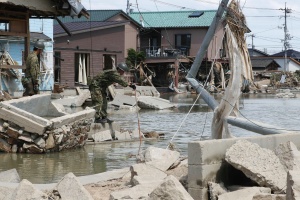Japan rescuers go house to house as flood toll hits 141
General |Author: AFP | July 10, 2018, Tuesday @ 08:10| 7122 views
Soldiers search for victims at a flood hit area in Kurashiki city, Okayama prefecture on July 9, 2018. Rescue workers in Japan battled on July 9 to reach residents trapped after devastating rains that have killed at least 100 people, as authorities warned about the risk of landslides. (AFP / JIJI PRESS)
(AFP) - Rescue workers carried out house-to-house searches Tuesday in the increasingly unlikely hope of finding survivors after days of deadly floods and landslides that have claimed 141 lives in one of Japan's worst weather-related disasters for decades.
The record downpours that began last week have stopped and receding flood waters have laid bare the destruction that has cut a swathe through the west of the country.
In the city of Kurashiki, the flooding engulfed entire districts at one point, forcing some people to their rooftops to wait for rescue.
By Tuesday morning, rescue workers were going door-to-door, looking for survivors -- or victims -- of the disaster.
"It's what we call a grid operation, where we are checking every single house to see if there are people still trapped inside them," an official with the local Okayama prefecture government told AFP.
"We know it's a race against time, we are trying as hard as we can."
In the Mabi district of Kurashiki, the water left behind a fine yellow silt that has transformed the area into moonscape.
Cars driving through kicked up clouds of dust. People walking around wore medical masks or covered their mouths with small towels to protect themselves against the particulates.
Stores were still closed, and inside one barber's shop the red sofas, customer chairs, and standing hairdryers were all covered with the same silt.
Fumiko Inokuchi, 61, was inside her home, sorting though the damage caused by floods that submerged the entire first floor.
She escaped the house on Saturday, crossing the street to take shelter in a three-storey care home for the elderly, from where she watched in horror as the waters rose.
"I saw my house sink underwater and I couldn't do anything at all, there was just nothing I could do. I felt helpless," she said, retrieving a photo of her children playing baseball.
"I got married here, and we built this house two years afterwards. We raised our three small sons to adulthood here, there are so many memories," she said, her eyes welling with tears.
- New dangers from heat -
The crisis is the deadliest rain-related disaster in over three decades, and one that has sparked national grief.
On Monday Prime Minister Shinzo Abe cancelled a four-stop foreign trip as the death toll rose.
Top government spokesman Yoshihide Suga said Tuesday that at least 141 people had been killed. Media said dozens more remained missing and the tally was expected to rise further.
Around 75,000 police, firemen and troops have been deployed in the search and rescue operation across parts of central and western Japan, Suga said, warning that hot weather posed new risks.
Thousands of people remain in shelters after authorities issued evacuation orders for as many of five million residents, and local authorities in some areas were offering drinking water and bathing services for those in homes without their own supply.
"It will be over 35 Celsius in some areas... Please be careful about heatstroke if you're doing reconstruction outdoors, and continue to be vigilant about landslides," Suga said.
The government said it would tap around $20 million in reserve funds to provide aid to those affected by the disaster. Abe was expected to visit the areas in coming days.
© Agence France-Presse
Back
